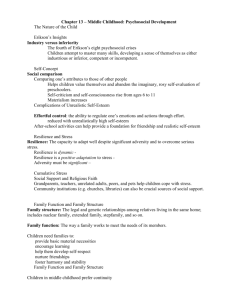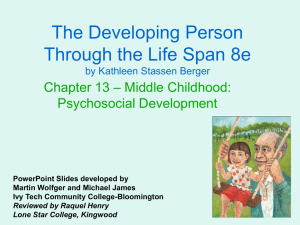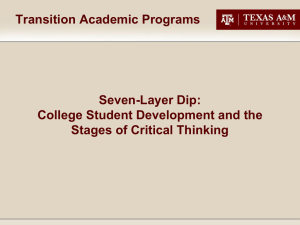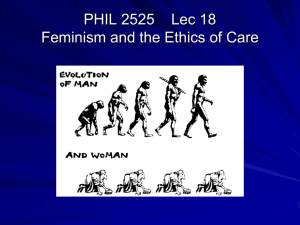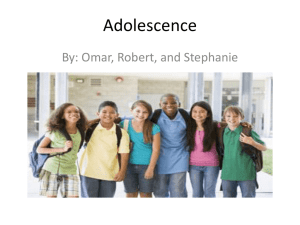Kohlberg`s theory of moral reasoning
advertisement
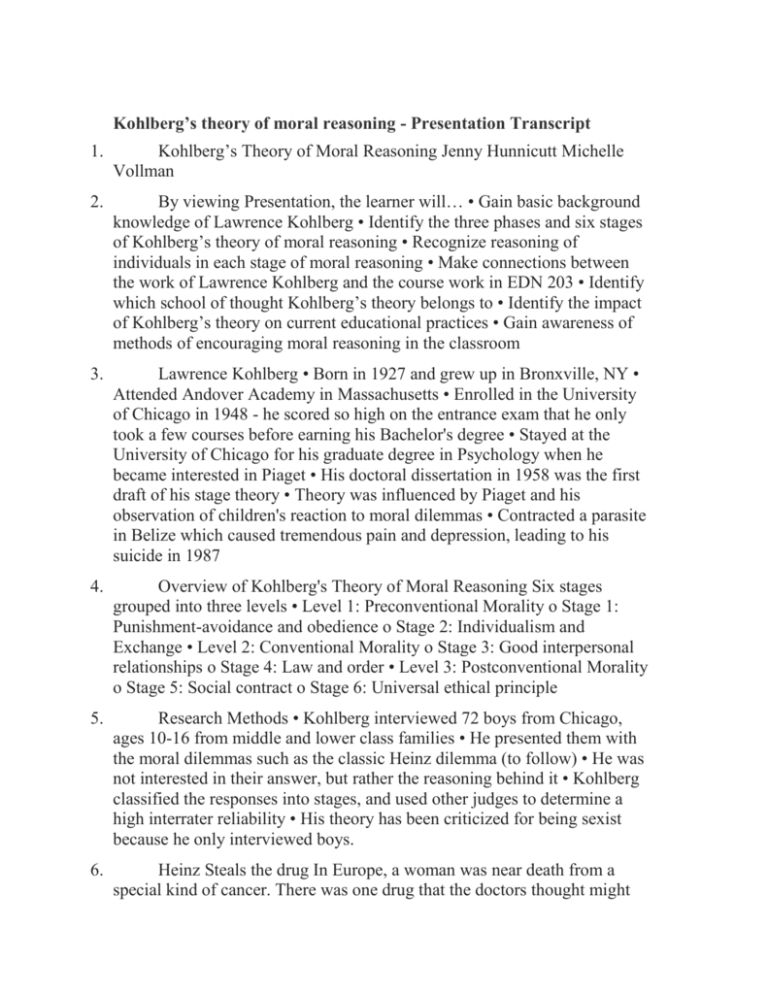
Kohlberg’s theory of moral reasoning - Presentation Transcript 1. Kohlberg’s Theory of Moral Reasoning Jenny Hunnicutt Michelle Vollman 2. By viewing Presentation, the learner will… • Gain basic background knowledge of Lawrence Kohlberg • Identify the three phases and six stages of Kohlberg’s theory of moral reasoning • Recognize reasoning of individuals in each stage of moral reasoning • Make connections between the work of Lawrence Kohlberg and the course work in EDN 203 • Identify which school of thought Kohlberg’s theory belongs to • Identify the impact of Kohlberg’s theory on current educational practices • Gain awareness of methods of encouraging moral reasoning in the classroom 3. Lawrence Kohlberg • Born in 1927 and grew up in Bronxville, NY • Attended Andover Academy in Massachusetts • Enrolled in the University of Chicago in 1948 - he scored so high on the entrance exam that he only took a few courses before earning his Bachelor's degree • Stayed at the University of Chicago for his graduate degree in Psychology when he became interested in Piaget • His doctoral dissertation in 1958 was the first draft of his stage theory • Theory was influenced by Piaget and his observation of children's reaction to moral dilemmas • Contracted a parasite in Belize which caused tremendous pain and depression, leading to his suicide in 1987 4. Overview of Kohlberg's Theory of Moral Reasoning Six stages grouped into three levels • Level 1: Preconventional Morality o Stage 1: Punishment-avoidance and obedience o Stage 2: Individualism and Exchange • Level 2: Conventional Morality o Stage 3: Good interpersonal relationships o Stage 4: Law and order • Level 3: Postconventional Morality o Stage 5: Social contract o Stage 6: Universal ethical principle 5. Research Methods • Kohlberg interviewed 72 boys from Chicago, ages 10-16 from middle and lower class families • He presented them with the moral dilemmas such as the classic Heinz dilemma (to follow) • He was not interested in their answer, but rather the reasoning behind it • Kohlberg classified the responses into stages, and used other judges to determine a high interrater reliability • His theory has been criticized for being sexist because he only interviewed boys. 6. Heinz Steals the drug In Europe, a woman was near death from a special kind of cancer. There was one drug that the doctors thought might save her. It was a form of radium that a druggist in the same town had recently discovered. The drug was expensive to make, but the druggist was charging ten times what the drug cost him to make. He paid $200 for the radium and charged $2,000 for a small dose of the drug. The sick woman's husband, Heinz, went to everyone he knew to borrow the money, but he could only get together about $ 1,000 which is half of what it cost. He told the druggist that his wife was dying and asked him to sell it cheaper or let him pay later. But the druggist said: "No, I discovered the drug and I'm going to make money from it." So Heinz got desperate and broke into the man's store to steal the drug-for his wife. Should the husband have done that? (Kohlberg, 1981, p. 19) 7. Level 1: Preconventional Morality Stage 1: Punishment-avoidance and obedience "It's against the law," or "It's bad to steal," as if this were all there were to it. When asked to elaborate, the child usually responds in terms of the consequences involved, explaining that stealing is bad "because you'll get punished" (Kohlberg, 1981). • Similar to Piaget's first stage of moral thought • Child views adult's rules as unquestionable • Child generally says it is wrong for Heinz to steal the drug, disregarding his motives • "Kohlberg calls stage 1 thinking "preconventional" because children do not yet speak as members of society. Instead, they see morality as something external to themselves, as that which the big people say they must do." (Crain 1985, 118-136) • Children see punishment as an unavoidable consequence of disobeying rules 8. Level 1: Preconventional Morality Stage 2: Individualism and Exchange "Heinz," they might point out, "might think it's right to take the drug, the druggist would not." Maybe he had a family at home and without his wife nobody would be home to watch them. But the druggist may have a family too and he has to make money. • children realize individuals have differing opinions • children see punishment as something to be avoided if possible • everyone is free to pursue their own interests • still see people as individuals, not members of a larger group 9. Level II: Conventional Morality Stage 3: Good interpersonal relationships It was really the druggist's fault, he was unfair, trying to overcharge and letting someone die. Heinz loved his wife and wanted to save her. I think anyone would. I don't think they would put him in jail. The judge would look at all sides, and see that the druggist was charging too much. (Kohlberg, 1981, p. 25) • Adolescents see others both as individuals and as members of unit (society, family, culture, class, team) • adolescents believe people should live up to their responsibilities within the family or community and behave in "good" ways • being "good" means having empathy, compassion, honesty, and concern for others 10. Level II: Conventional Morality Stage IV: Law and Order If everybody did as he wanted to do, set up his own beliefs as to right and wrong, then I think you would have chaos. The only thing I think we have in civilization nowadays is some sort of legal structure which people are sort of bound to follow. [Society needs] a centralizing framework. (Crain, 1985, p. 118-136) • Individuals are making decisions based on the implications on society, showing they now see themselves as members of a group • emphasis is on maintaining social order through fulfilling responsibilities and obeying the law 11. Level III: Post-conventional Morality Stage V: Social Contract It is the husband's duty to save his wife. The fact that her life is in danger transcends every other standard you might use to judge his action. Life is more important than property. • Morals and rights are seen to be superior to certain laws • "basically believe that a good society is best conceived as a social contract into which people freely enter to work toward the benefit of all They recognize that different social groups within a society will have different values, but they believe that all rational people would agree on two points. First they would all want certain basic rights, such as liberty and life, to be protected Second, they would want some democratic procedures for changing unfair law and for improving society." (Crain, 1985, p.118-136) 12. Level III: Post-conventional Morality Stage VI: Universal Principles • hypothetical ideal which few people ever achieve. • People adhere to a few abstract, universal principles (equality of all people, respect for human dignity, commitment to justice) that transcend specific norms and rules • People answer to a strong inner conscience and willingly disobey laws that violate their own ethical principles Omrod, 2009, p. 96 13. Kohlberg's influence on Education • Kohlberg suggested to help children wrestle with moral dilemmas, teachers should offer reasoning one stage above a child's current stage o Teenage boy is concerned primarily about gaining peer approval (stage 3) and often lets a popular cheerleader copy his homework. His teacher might present law-and- order logic (stage 4) suggesting that because homework assignments are designed to help students learn more effectively, all students should complete them without other's assistance. (Omrod 2008, 98) • If teachers present arguments too much higher than children's current reasoning, children will have trouble understanding their logic and will benefit little. 14. Classroom discussions of controversial topics and moral issues appear to promote increased perspective taking and the transition to more advanced reasoning (Omrod, 2009, 97) • Children’s moral reasoning is formed from their own experiences, not just from the values taught by adultsKohlberg's influence on Education • Contemporary developmental psychologists disagree with Kohlberg's stages • Researchers have confirmed the idea that disequilibrium spurs moral development. 15. Encouraging Moral Behavior and Development in the Classroom (Omrod, 2008, p. 98-99) • Give reasons that some behaviors are unnacceptable • Encourage perspective taking, empathy, and prosocial behaviors • Expose students to numerous models of moral behavior • Engage students in discussions of moral issues related to academic subject matter • Get students actively involved in community service 16. How does the theory inform what we understand about the process of learning, relating, or growing? • Kohlberg’s theory deals more with the atmosphere of the classroom setting and how the students and the teacher interact with each other in an educational environment • As children grow they go through the different levels of moral development and each stage can alter the learning environment of the classroom 17. Kohlberg focuses on morality and the stages of developing that morality as a child grows. I think first and for most, a child gets their first sense of morality for their guardians whether that be their parents, grandparents, foster parents … and the atmosphere that a child is raised in is a determining factor in journey through the moral stages. 18. Example A child growing up in a very moral house might not have known what was wrong or right was they did know that if they hit their siblings they would be yelled out so because of the negative consequence, that child didn’t lash out at their siblings. Whereas at another household, a child who hits their siblings receives no negatives consequences will continue to do it. This impacts the educational atmosphere because a child who does not receive negative consequences at the home might lash out at the other students at school as they see fit of resolving an argument. This can affect the learning environment and the prevent the other students from receiving the most out of their education if the teacher is constantly trying to redefine the consequences of one student’s actions. This can even lead to rebellion in other stages of moral development. 19. How does the theory impact how you think about education? • Allows insight to the challenges I will encounter, such as differing views on equality, race, money, personal achievement, collectivism, and independence. • Allows me to view each student in a different light and realize the backgrounds they may come from can effect the way they progress through the moral development levels. 20. How does the theory or contribution relate to what you are reading in the textbook? • Kohlberg is the precursor to other theorists and their theories about development and education • It is key to help unlocking how a child’s mind works so that we can assist them in solving their problems and helping them to see the difference between right and wrong 21. What school of thought (i.e. behaviorism, constructivism, social cognitive views,etc.) does the theory or contribution influence? • It most definitely contributes to the influence of social cognitive views and behaviorism, especially in a classroom setting and when dealing with other students • Is related to behaviorism because morality deals with judgments and the types of decisions that are made which in turn, plays a large role on how a child behaves • Is related to social cognitive views because in each level of morality there is a process in which the child goes through to determine if something is right or wrong. This happens mostly in a social setting and contributes largely to their social thinking views 22. Connections between Kohlberg’s theory and EDNtheorist in the field of • Kohlberg is a ground breaking 203 educational psychology. Although modern psychologists may not completely agree with the division of his stages, they have research backing the use of moral dilemmas to engage students in internal thinking. • Kohlberg’s theory discusses the process behind a significant developmental process (moral reasoning) which is an essential aspect of teaching. • One of the many roles a school plays is the training of students in proper social behaviors. The morals and ethics students learn (sharing, honesty, responsibility, empathy, respect for authority) assist them in becoming responsible and contributing citizens in society. 23. Connections between Kohlberg’s theory andmoral level students are in at particular • Kohlberg’s theory uses the EDN 203 ages to explain the reasoning behind their conclusions in moral dilemmas. • These levels should be a considered psychological factor by teachers when working with children. They cannot be expected to come to a law and order (stage 4) type conclusion when they are only in the individualism and exchange stage (stage 2) – however by presenting logic found within the good interpersonal relationships stage (stage 3) would be an effective way to deepen their thinking and perspective, and usher them into the third stage or reasoning. 24. Connections between Kohlberg’s theory and EDN 203 • The use of moral dilemmas to teach children moral reasoning and ethics is a model of instruction intended to enhance cognitive development. • The following is a list of websites intended to assist adults in using moral dilemmas with children: – http://www.minti.com/parenting-advice/5200/Parenting-TipsHow-Moral-Dilemmas – http://www.goodcharacter.com/dilemma/dilemma3.html – http://www.42explore2.com/character.html 25. Resources Kohlberg, L (1981). The philosophy of moral development: moral stages and the idea of justice. San Francisco: Harper & Row Omrod, J.E. (2008). Educational Psychology: Developing Learners (6th ed). New Jersey: Pearson W.C. Crain (1985). Theories of Development. Retrieved from http://faculty.plts.edu/gpence/html/kohlberg.htm
